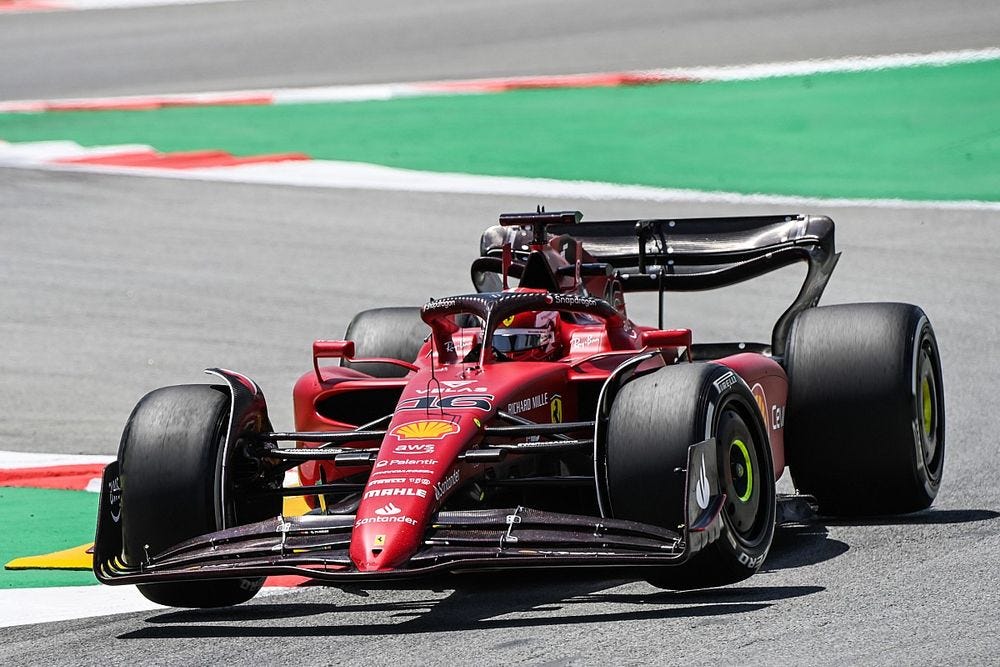What is porpoising?
Everyone was excited for the new 2022 Formula 1 regulations that would allow for closer racing and easier overtaking. However, one thing that nobody expected was the prevalence of porpoising. Porpoising is when the car bounces up and down on the race track just like a porpoise does in the water.
Click here to watch cars porpoising at the Spanish GP
What is the ground effect?
Porpoising mainly happens due to something called the ground effect. The ground effect is when the car gets sucked to the track to increase downforce. This happens because of new aerodynamic changes in the 2022 cars. These cars have new floors that include venturi tubes and diffusers that increase the velocity of the air underneath, creating low pressure which sucks the car to the ground. The reason why low pressure is created is because of the Bernoulli principal. This states that
an increase in the speed of a fluid occurs simultaneously with a decrease in pressure
Venturi tubes apply this knowledge by constricting airflow. Assuming a constant volume flow, the air inside the smaller tube will have to flow faster. But we know that a change in speed requires a change in kinetic energy. That must mean that work is being done. The air behind the air in the tube must have a greater pressure so that it can do work and speed up the air inside the tube.
As cars go faster and faster, they get sucked closer to the ground further increasing speed. Porpoising happens when at some point the car gets so close to the track due to the ground effect that the air underneath stops flowing and stalls. The downforce is lost and the car bounces up from the track. However, once the car is at its high point, the air can flow under the car and it gets sucked back down. Once again, the air stalls and the car bounces back up. This is porpoising.
Why is this a problem?
Porpoising is a problem for many reasons. Imagine driving down a straight at over 180mph (290kph) but your car is bouncing up and down. Visually that would be very difficult to drive accurately.
Already you can see that drivers do not have the greatest visibility but add on porpoising and that creates a very unmanageable car.
Additionally, it would not be comfortable either. Lewis Hamilton, driver for Mercedes and seven time world champion, said that he has experienced headaches since the beginning of the season as well as back pain due to the severe bouncing. Drivers experience heavy pressure on their neck and spine, so taking up to 10 Gs while bouncing could have real safety concerns. Not only is porpoising unsafe, but it takes speed away from the car. Downforce is being applied and then taken away constantly when the car is released from the suction.
How can we fix this?
The easiest way to fix this would be to raise the driving height of the car. However, many teams do not want to do this as it would take away a lot of speed from the car. The FIA has actually implemented changes to the 2023 car to prevent porpoising. This includes raising the edge floor height as well as the diffuser throat height. Teams are divided about these rule changes because not every car has experienced porpoising equally. Teams like Mercedes welcome this change and hope that it will reduce the amount of bouncing their cars have on the track while teams like Red Bull feel like the rule changes are not specific enough and that there already isn’t enough time to experiment with the cars before each race season.
Other applications of the Bernoulli Principal
Ever wonder how heavy planes are able to fly in the first place? That is due to some clever engineering with the wing flap that uses the Bernoulli principal to create higher pressure under the wing and lower above. This raises the wing and that is how the plane flies!
Sources
https://cdn-1.motorsport.com/images/amp/6VR1l1d6/s1000/charles-leclerc-ferrari-f1-75-.jpg
https://s1.cdn.autoevolution.com/images/news/gallery/f1-helmet-cam-clip-shows-why-charles-leclerc-is-poised-for-greatness_2.jpg
https://www.nasa.gov/sites/default/files/atoms/files/bernoullis_principle_k-4-02-09-17-508.pdf
https://skybrary.aero/articles/bernoullis-principle
https://energyeducation.ca/encyclopedia/Venturi_effect#:~:text=The%20Venturi%20effect%20describes%20how,static%20pressure%20of%20the%20fluid.
https://us.motorsport.com/f1/news/f1-2023-floor-roll-hoop-rules-changes-ratified-by-fia/10353607/
https://www.formula1.com/en/latest/video.cars-experience-bouncing-porpoise-effect-on-track-in-spain.1725661674440965177.html
https://www.racecar-engineering.com/tech-explained/diffusers-engineering-basics-aerodynamics/
https://www.racefans.net/2022/07/23/fias-floor-change-is-needed-to-stop-cars-bottoming-out-and-crashing-mercedes/






